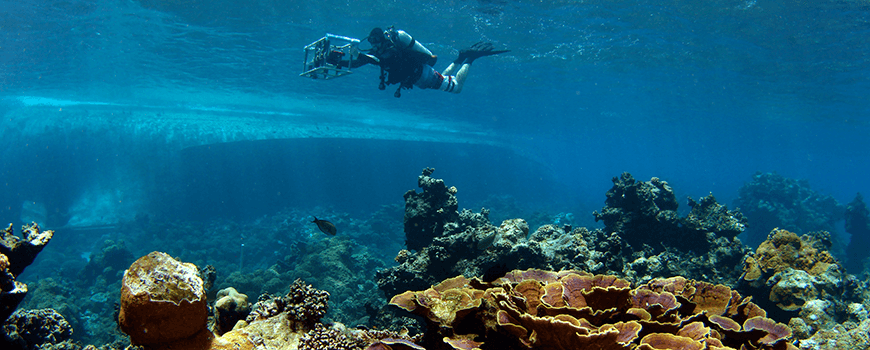Apr 12 2019
New imaging software was used by researchers and engineers at Scripps Institution of Oceanography and UC San Diego, respectively to identify remarkable recovery following a bleaching event on the reefs surrounding distant Palmyra Atoll located in the tropical Pacific. The study results were reported in Coral Reefs on April 5th, 2019.
 Image credit: Brian Zgliczynski
Image credit: Brian Zgliczynski
Earlier in 2015, the Palmyra island experienced its warmest water ever recorded in history, triggering an extensive bleaching event that had an impact on more than 90% of the corals surrounding the island. In spite of the extensive bleaching, a majority of the corals recovered with less than 10% dying, discovered the researchers.
These conclusions are predicated on detailed monitoring of the reefs and are offering much more accurate observations of how reefs are altering over time. A long-term data set of a countless number of pictures of the same reef area gathered over a span of eight years was used by the research team. With the help of custom software, these images were stitched together to produce 3D photo mosaics of the entire ecosystem, thus providing a virtual representation of the corals. The novel technology was devised by the 100 Island Challenge team—a collective team of marine engineers and ecologists—using the contemporary technology to track coral reefs worldwide.
This imaging provides a way of getting back into the environment in a virtual world. It allows us to bring the reef back into the lab.
Mike Fox, Study Lead Author and Postdoc, Woods Hole Oceanographic Institution
Fox completed the study when he was a PhD student at Scripps.
The scientists integrated this latest imaging technology with a novel custom visualization software called VisCore, that enables users to re-inspect the unlimited numbers of photographs containing the mosaics of the ecosystem. The VisCore software captured over 15,000 images for each 10 m2 area of coral reef and subsequently processed the data to convert the images into a 3D map that can be viewed by users in virtual reality.
By bringing a highly interdisciplinary research group together, the 100 Island Challenge truly revealed another dimension to VisCore, creating the data, tools, and algorithms that are currently enabling researchers to virtually examine reefs in the laboratory; to monitor the growth and decline of separate colonies; to travel in time virtually from year to year; and to analyze temporal and spatial associations across the reef.
According to Falko Kuester, a professor of computer science and structural engineering at UC San Diego, the project was made feasible by bringing together investigators from the Jacobs School of Engineering at UC San Diego and Scripps with a deep dedication to the project.
“We want to give coral reefs a voice, to tell their stories and engage stakeholders to safeguard them,” he stated.
The program gave us the unique opportunity to virtually re-visit each of our dives and to examine the reef with a new focus. When we ‘dove’ back into the images, we realized that the bleaching was even worse than we remembered when we were actually diving on the reef collecting the data.
Mike Fox, Study Lead Author and Postdoc, Woods Hole Oceanographic Institution
Together with recording the bleaching event, the team was able to closely track the recovery of corals. Looking at the reef’s photomosaics following the bleaching event, Fox and group successfully recorded growth in a key reef-building species called crustose coralline algae. It is these algae species that help hold the reefs together and can promote the settlement of juvenile corals.
In regions where corals actually died and were enclosed with reef-suffocating algae, the investigators observed that these algae species were substituted by the pink crustose coralline in roughly a year. This is partly because of the health of the bigger ecosystem, as Palmyra has strong populations of herbivorous fish that can manage the destructive growth of algae.
Monitoring these recovery processes at certain colonies of corals over time provides investigators a better insight into how separate corals—and the bigger reef they are a part of—are managing with environmental stresses in the period of climate change influenced by humans.
Conventionally, transect sampling is performed to measure the changes in coral reefs, wherein divers record observations along a particular line over the reef.
It’s like trying to measure national population growth by going to one random U.S. city and asking people if they had a child. You’re not going to show the larger picture.
Stuart Sandin, Study Co-Author and Researcher, Scripps Institution of Oceanography
Sandin is also the co-founder of the 100 Island Challenge
The reef mosaics combined with the pinpoint precision of the VisCore software, coral researchers can look at demographic cues in a huge area. The data’s colony-specific nature provides more accuracy, and similar to tracking the growth of population in a country, can reveal national and regional trends.
Using a combination of novel technology and more traditional approaches, our team was able to show that the reefs of Palmyra did not suffer the same fate as many other reefs during the recent global bleaching event. Despite extreme heating, corals were able to recover without experiencing widespread mortality. These findings certainly provide an important counterpoint to the general decline in reef health being reported globally.
Jen Smith, Study Senior Author and Researcher, Scripps Institution of Oceanography
Smith is the other co-founder of the 100 Island Challenge.
Computer and robotics engineering Eric Lo; development engineer Vid Petrovic; software engineer Chris McFarland; computer science graduate student Dominique Meyer; and ocean science graduate student Hugh Runyan were also part of the 100 Island Challenge technology team from the Cultural Heritage Engineering Initiative of UC San Diego.
The study was funded by generous donations from the Scripps Family Foundation, the Wilson family, the Bohn Family, Marcia Grand and a number of other anonymous donors to the Smith and Sandin laboratories between 2009 and 2018.
Advanced Virtual Technology Captures How Coral Reefs Recover After Bleaching
Video credit: Scripps Institution of Oceanography